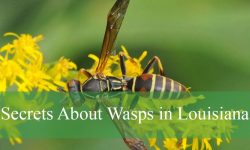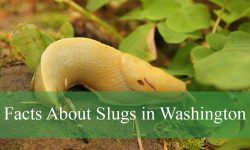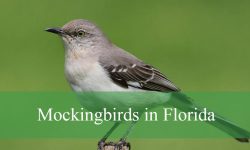Michigan’s diverse aquatic landscapes serve as a haven for a variety of duck species throughout the year. From the striking colors of the male Wood Duck to the distinctive calls of the Northern Shoveler, the ducks of Michigan provide a captivating experience for bird enthusiasts.
In this article, we will explore 27 duck species found in Michigan and how to identify and distinguish them.
Different Types of Ducks in Michigan
Gadwall
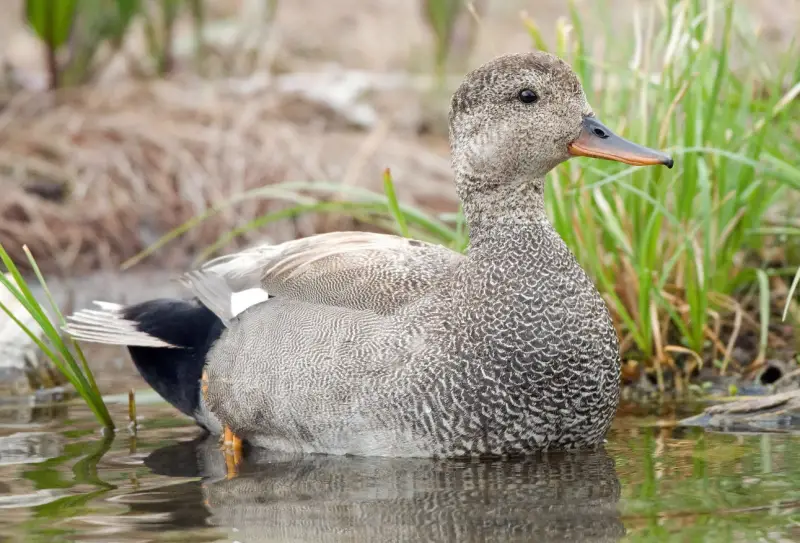
Gadwalls are subtle, often overlooked ducks in Michigan. Males have intricate gray, brown, and black feather patterns that resemble white-fringed “scales.” They have brown heads and dark gray or black bills, with medium and dark brown feathers on their backs. Females are mottled brown, resembling female Mallards, with a dark orange-black bill. Both sexes have a white patch on their wings, more prominent in males, visible when flying.
Gadwalls prefer small ponds with plenty of vegetation. Males have a unique “burping” call, while females quack similarly to Mallards, though slightly higher-pitched. They are known for stealing food from diving ducks, especially American Coots.
Ruddy Duck
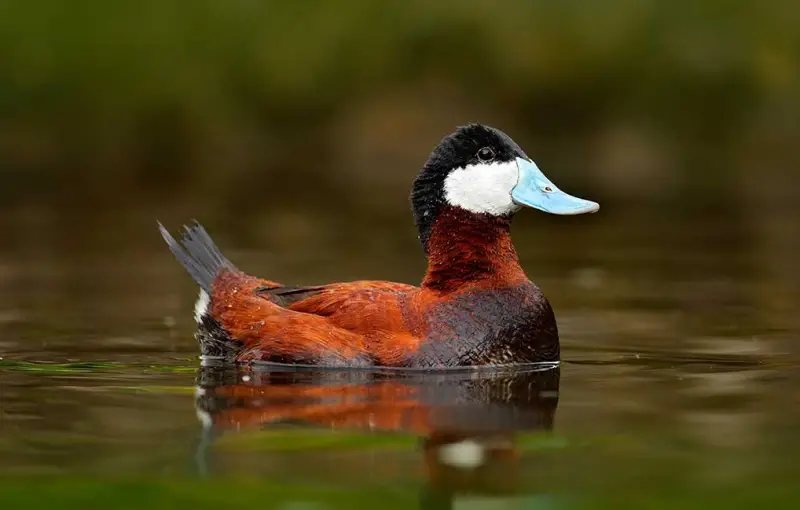
Ruddy Ducks are intriguing ducks found in Michigan, known for their distinctive appearance and behavior. Breeding males are particularly striking with their blue bills, white cheeks, black caps, and chestnut-colored bodies. Their stiff black tail is typically held erect. Females are tawny brown with a darker cap and have a black, scoop-like bill, which is also found on nonbreeding males.
One of the most notable features of Ruddy Ducks is their unique courtship display. Males will beat their bill against their neck, forcing air through their feathers to create a swirl of bubbles in the water, accompanied by a belch-like sound. This display is believed to attract females.
Ruddy Ducks are better swimmers than flyers; they prefer diving and swimming away from predators rather than taking to the air.
Redhead
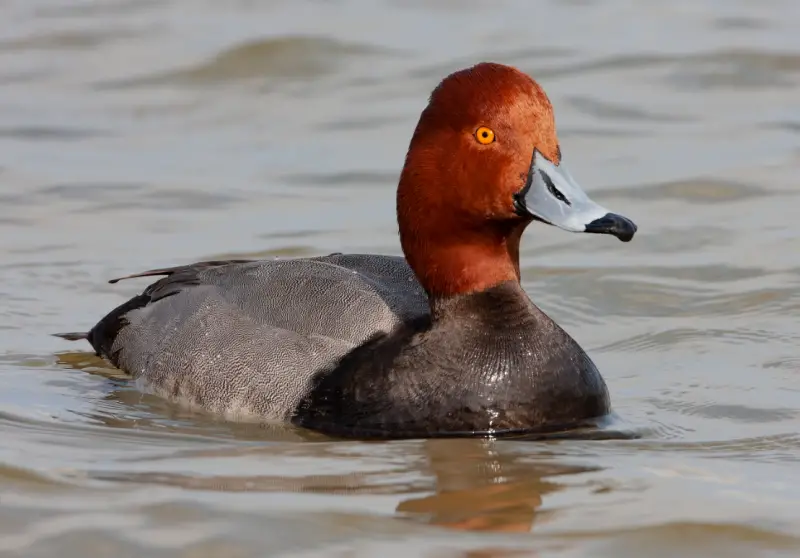
Redheads are sociable ducks often seen in large flocks, particularly in Michigan during the winter. Both sexes have a steep forehead and a black-tipped gray bill. Males stand out with their distinctive cinnamon-red head, yellow eyes, gray body, and black chest. Females are brownish overall with a paler face and dark eyes.
Redheads are known for their gregarious nature, which makes them a popular target for hunters using decoys. Female Redheads engage in brood parasitism by laying some of their eggs in the nests of other duck species, such as Mallards, Canvasbacks, and Northern Pintails, while still building their own nests and raising some hatchlings themselves.
Males produce a cat-like “whee-uogh” or “keyair” call to attract females and emit a low, trilling “rrrrr” when threatening other Redheads.
Ring-necked Duck
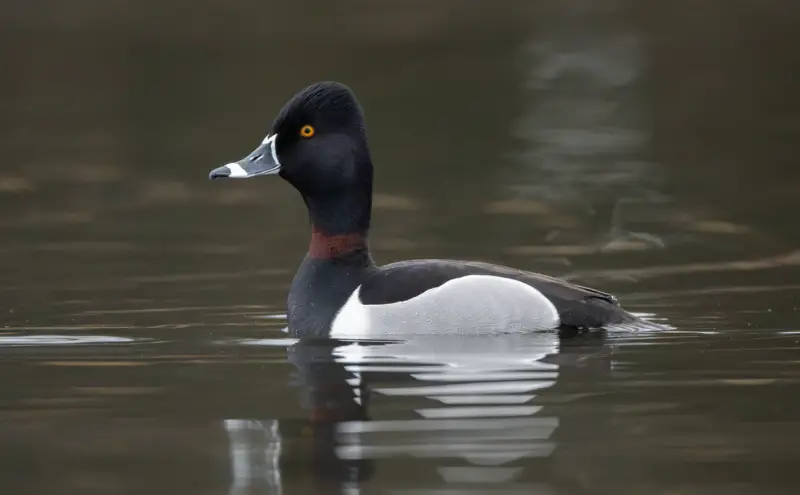
The Ring-necked Duck is a medium-sized duck with a distinctive peaked head and a gray bill with a white band and black tip. Males are characterized by their glossy black head, chest, and back, with contrasting gray sides and yellow eyes. Females are brownish with a gray face and throat, and they have a hint of white around their dark eyes.
Contrary to what their name suggests, the “ring” on their necks is very faint and often hard to see. These ducks are more commonly found in shallow ponds and wetlands across Michigan, where they tend to form large flocks during winter, although they are usually seen in pairs during the breeding season.
Historically, Ring-necked Ducks have been at risk from ingesting lead pellets, a problem reduced since the 1991 ban on lead shot. However, remnants of old ammunition can still pose a threat in some areas.
Common Goldeneye
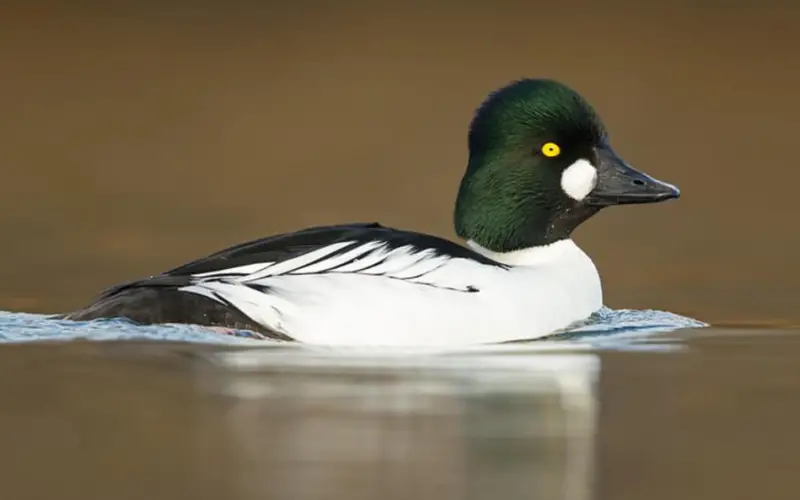
The Common Goldeneye is a striking duck with distinct features that make it relatively easy to identify. Males are notable for their dark green head, bright yellow eye, and a distinctive white cheek patch, paired with a body that is mostly white with a black back and rump. Females have a brown head, a short dark bill with a yellow tip, and a pale yellow eye, along with a white neck collar and grayish body.
In Michigan, Common Goldeneyes are skilled divers, capable of staying underwater for up to a minute while searching for prey such as aquatic invertebrates, fish, fish eggs, and seeds from submerged plants. Their population is currently stable, but they rely on cavity-nesting sites provided by dead trees, which makes them vulnerable to habitat changes due to logging.
Known as “whistlers” among hunters due to the distinctive whistling sounds their wings make in flight, Common Goldeneyes are generally silent except during courtship. To support their nesting needs, many enthusiasts have installed nest boxes in their breeding areas.
Northern Pintail
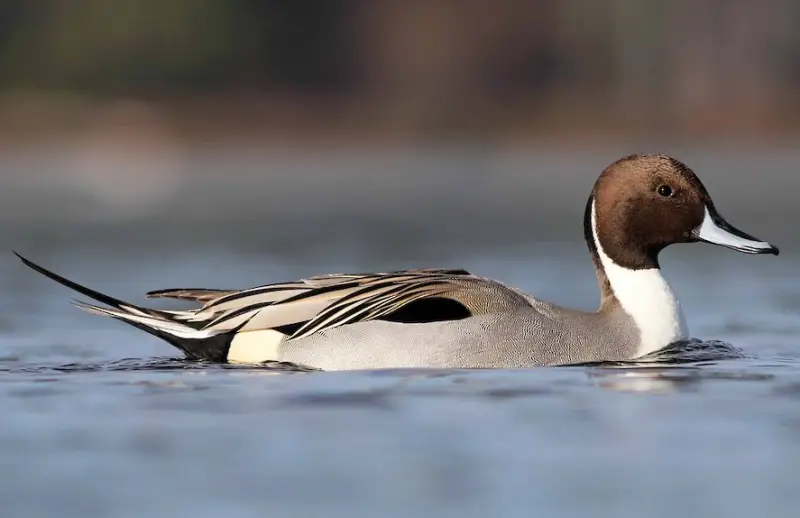
Northern Pintails are slender ducks with long necks and tails, and they have a pale black-gray bill. Males are distinguished by their cinnamon-brown heads, gray bodies, and white throats and breasts, while females have plain tan heads and rufous-brown bodies. Their long necks and pointy tails are notable, with the tail sticking out even when floating. Non-breeding males and females have shorter but still noticeable tails.
These ducks prefer wetland habitats away from people, often found near the edges of lakes and ponds. Males make a call resembling a train whistle, while females quack with low-pitched “kuk” sounds. Northern Pintails are excellent flyers, migrating at night and reaching speeds of 48 mph.
Northern Shoveler
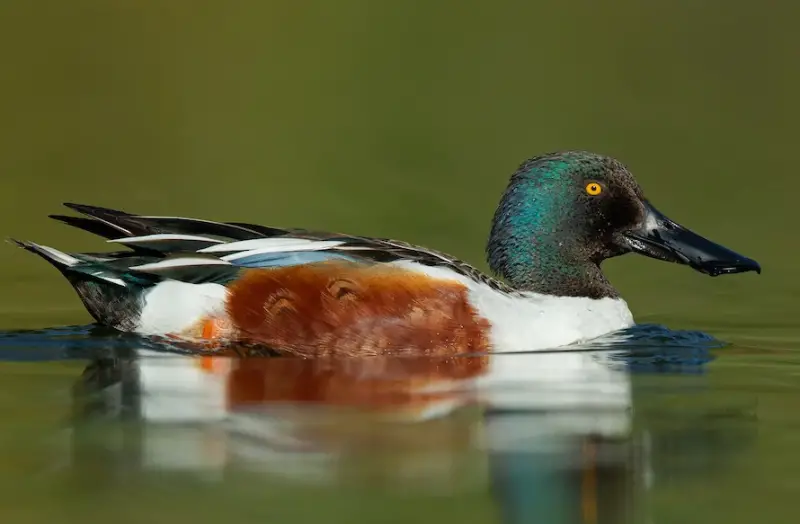
Northern Shovelers are easily recognized by their large, wide bills. Males have green heads, reddish-brown flanks, a white chest, black backs, and yellow eyes. Females are brown and may show a bluish shoulder patch. Both sexes have the distinctive spoon-shaped bill, which they use to sift through mud and sand for food like crustaceans, mollusks, and aquatic insects. Their bills have over 100 tiny projections, called lamellae, that help filter out their meals.
While males make a guttural “took-took” sound during courtship or in flight, females produce a nasally quack. These ducks are also known to team up, swimming in circles to stir up food.
Blue-winged Teal
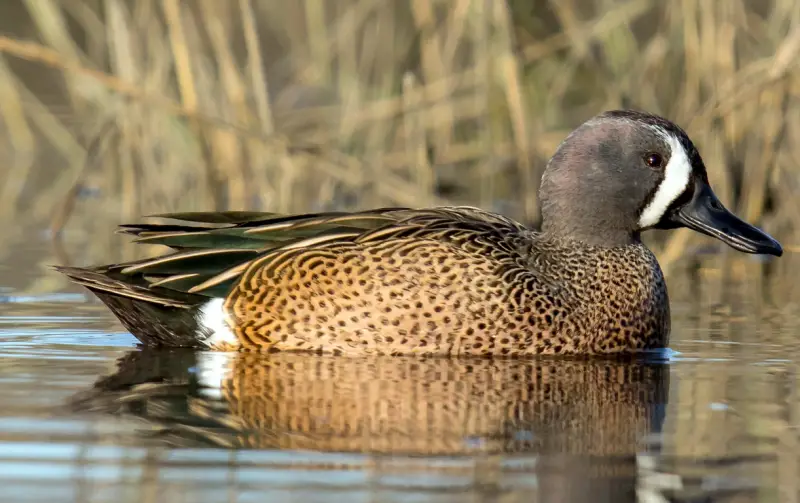
Blue-winged Teals are small ducks easily recognized by the striking colors on the males. Males have a bluish head with a white band in front of the eye, a black bill, black wings, and a brown body with black spots. Females are brown with a distinctive dark eyeline and crown on their heads.
These ducks get their name from the blue shoulder patch visible only when in flight, with green plumage below. Blue-winged Teals are commonly found in shallow wetlands across Michigan and are the second most abundant duck in North America, behind only the Mallard. Males make a high-pitched “tsee-tsee” sound.
Mallard
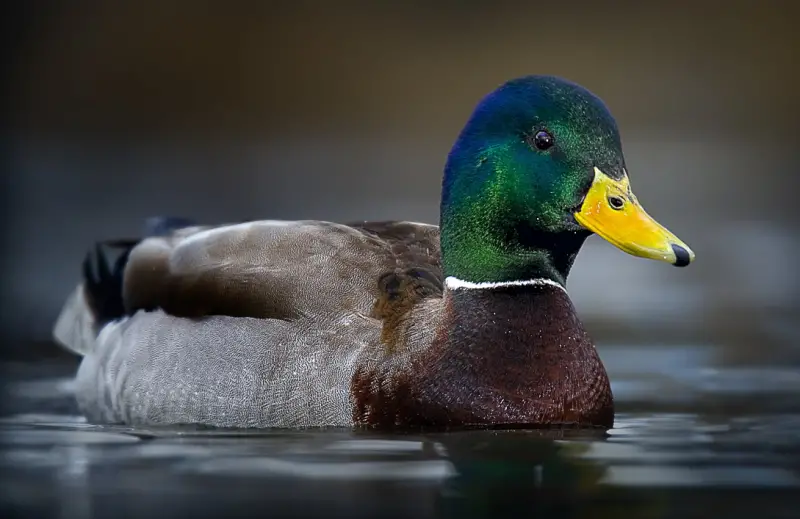
Mallards are one of the most recognizable ducks, especially in Michigan. Males have a bright green head, a thin white collar, a dark reddish-brown chest, a yellow bill, and a black rump with a white-tipped tail. Females are mottled brown with orange and brown bills. Both sexes display purple-blue feathers on their wings, visible while standing or flying.
These adaptable ducks thrive in various wetland habitats and are comfortable around people, sometimes even visiting swimming pools! Mallards readily use human-made nesting structures, and while females quack, males make a distinct raspy call.
American Wigeon
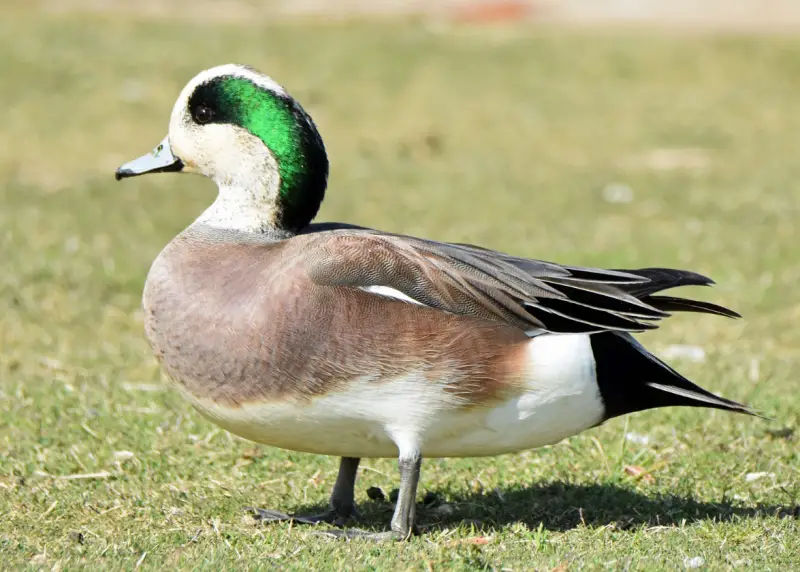
American Wigeons are compact ducks with round heads and blue-gray bills tipped in black. Males are mostly brown, featuring a distinctive green band behind their eyes and a white crown. Females have overall brown bodies with a grayer head. Unlike Mallards, American Wigeons prefer quiet lakes and marshes away from human activity.
They have a diet rich in plant matter and will often feed in farm fields like geese. Their short bills are powerful for plucking vegetation. Males are known for their 3-part nasal whistle, which sounds like a kazoo, while females make a harsh grunt quack.
Green-winged Teal
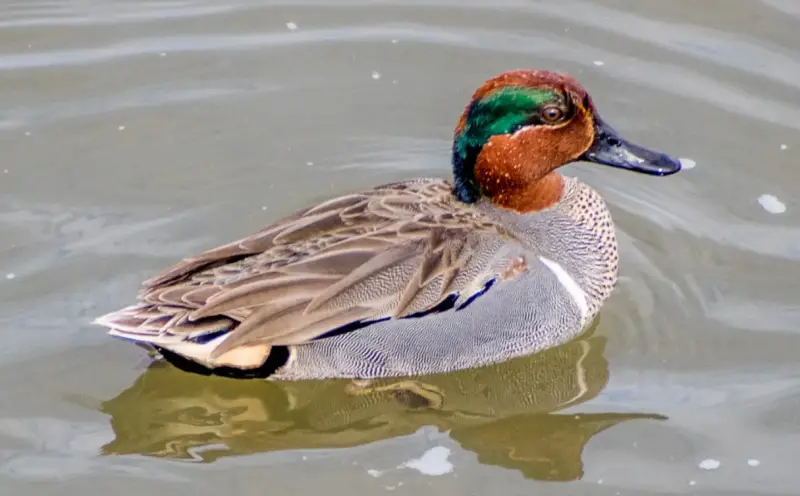
Green-winged Teals are the smallest dabbling ducks in Michigan, measuring 12-15 inches (31-39 cm) in length and weighing between 5 and 18 ounces (140-500 g). Males are easily identified by their chestnut-brown heads, green ear patches, and gray-barred bodies with white stripes. Females are mottled brown with a dark eyeline. Both sexes have a green patch on their wings, visible in flight or when resting.
These ducks often mix with other species, and their smaller size helps distinguish them. Green-winged Teals have increased in population in Michigan, despite being the second most hunted duck in the U.S. Males produce a short, clear whistle, while females quack year-round.
Wood Duck
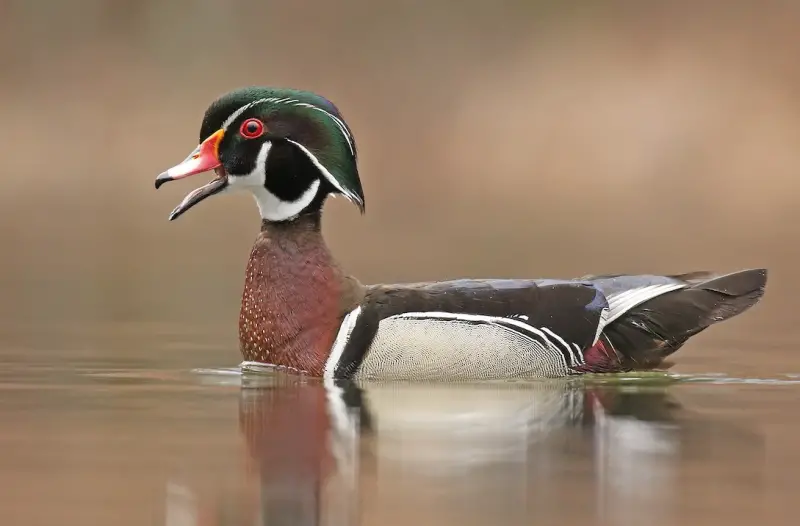
Wood Ducks are some of the most colorful and unique waterfowl in Michigan. Males have incredibly intricate plumage, featuring a green crested head, red eyes, and a chestnut breast with white flecks. Females are more subdued, with brown bodies, a grayish crested head, a white teardrop eye patch, and a blue patch on their wings.
Unlike most ducks, Wood Ducks often nest in trees, using abandoned cavities or elevated nesting boxes. Their powerful claws allow them to perch on branches. When disturbed, they fly away with a loud “ooeek-ooeek” call. Hatchlings famously leap from high nests, sometimes from as high as 50 feet, to reach the ground!
American Black Duck
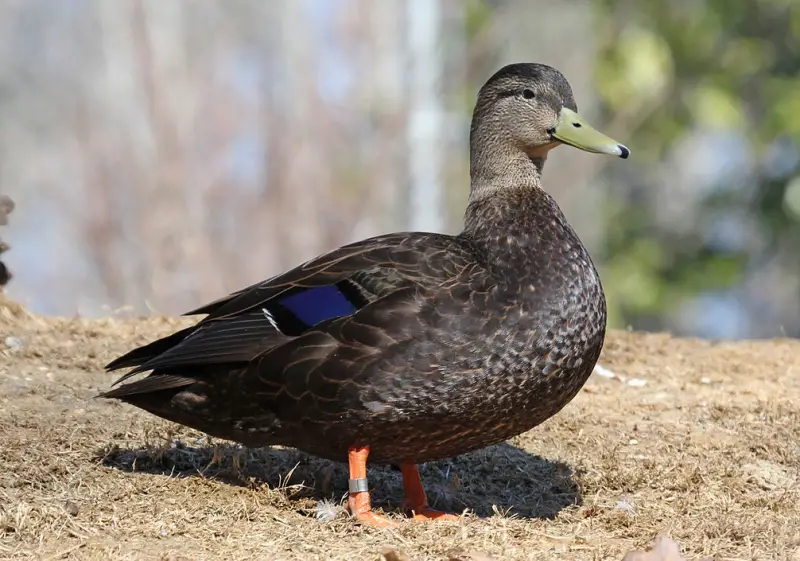
American Black Ducks are often mistaken for their namesake due to their dark coloration. Both males and females have dark brown bodies with pale brown heads. Males have a yellow bill, while females have a dull olive bill. When in flight, look for the iridescent purple rectangle on their wings.
Despite their name, these ducks don’t actually have black plumage. They are commonly found in shallow wetlands in Michigan, frequently foraging alongside Mallards. American Black Ducks can be difficult to distinguish from female Mallards, so pay attention to large flocks. Males produce a flutelike whistle to attract mates, while females make loud “quacks.”
Muscovy Duck
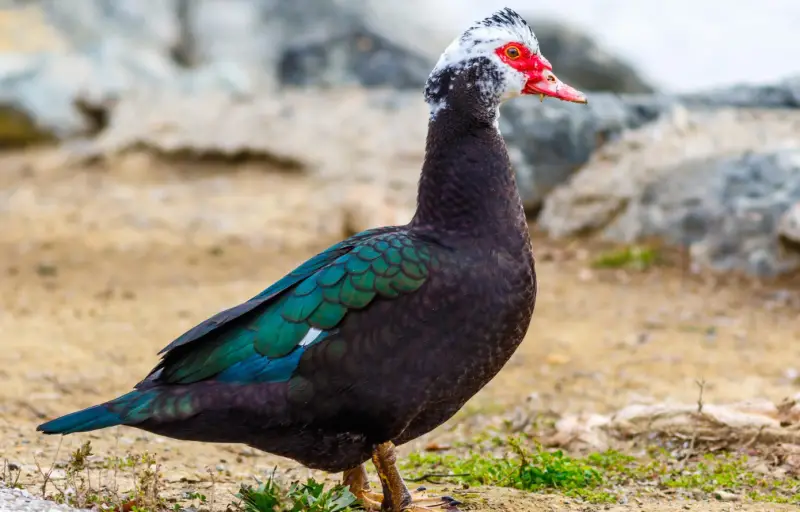
Muscovy Ducks are heavy-set domesticated ducks, with males often twice the size of females. They are typically white and black, with dark green plumage around their wings, and feature prominent red wattling around their bill and face.
While wild Muscovy Ducks are native to the American continent, they’re rarely seen in Michigan as they are usually domesticated birds that have escaped. These ducks were among the first to be domesticated in South America and later introduced to Europe. Through selective breeding, a variety of domesticated breeds have emerged.
Domesticated Muscovy Ducks are large with noticeable red wattling and knobs above the beak, whereas wild Muscovy Ducks are more slender and athletic. In Michigan, you are most likely to encounter Muscovy Ducks on farms, in parks, or as part of feral populations. Escaped domestic ducks may sometimes breed with other species, resulting in sterile offspring.
Long-tailed Duck
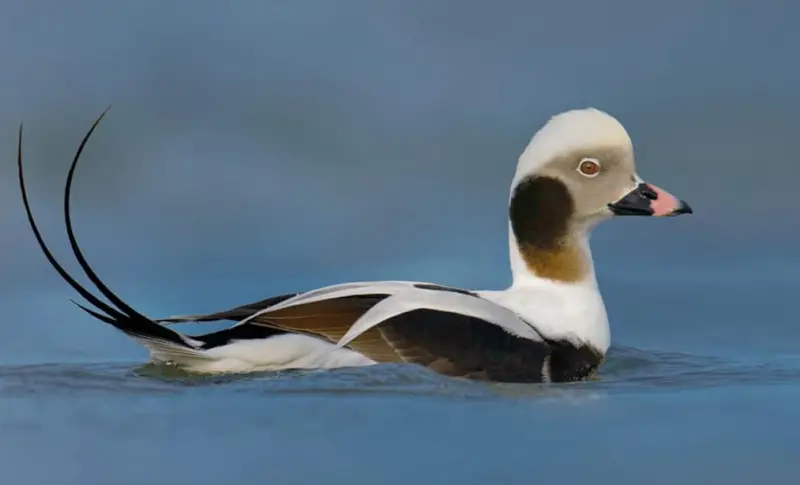
Long-tailed Ducks exhibit dramatic seasonal changes in appearance. In winter, when they migrate south, you can see them in Michigan, as they are not typically found here during their breeding season around the Arctic Circle. Males are known for their long tails, which are absent in females, who have consistently short tails.
These ducks are adept divers, often seen in coastal or saltwater environments, including estuaries and brackish waters. Occasionally, they may also appear in large, deep freshwater lakes. Their impressive diving skills allow them to reach depths of up to 200 feet (60 meters) as they use their wings to propel themselves underwater in search of small fish, mollusks, and crustaceans.
Black Scoter
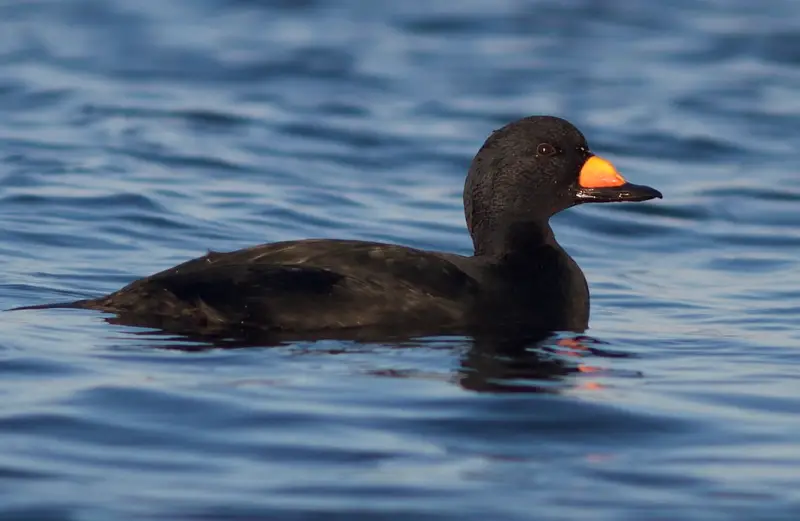
Black Scoters are strikingly distinct in appearance and behavior. Males are entirely black with a distinctive bill: black at the base and a vibrant orange and bulbous upper part. Females, on the other hand, are a soft brown with noticeable white cheek patches.
During the breeding season, male Black Scoters engage in dramatic courtship displays. They compete fiercely for the attention of females, performing a variety of actions, including sing-song whistling calls, head-shaking to showcase their bright bills, and short flights or wing-flapping. Their displays culminate in a head-dipping motion that highlights their commitment and vigor.
In the summer, Black Scoters are found in northern Canada and Alaska, where they are excellent at hunting mussels. As winter approaches, they migrate southward, spreading across North America. They prefer shallow seawater habitats with rocky or sandy bottoms, where they can efficiently forage for crustaceans and mollusks.
White-winged Scoter
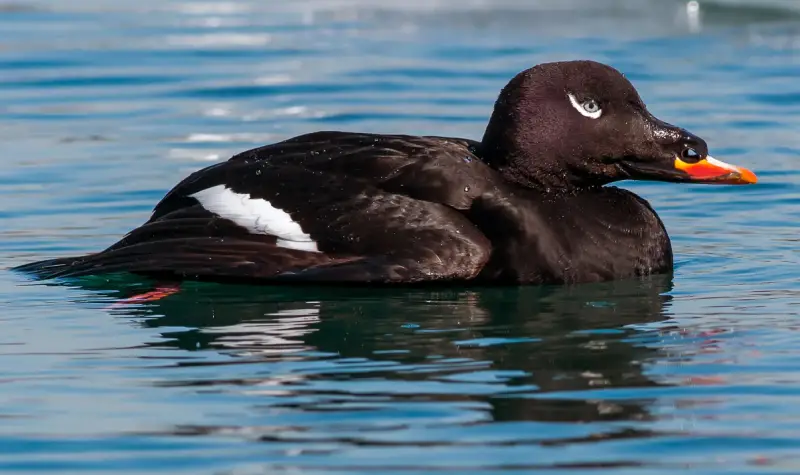
Bufflehead
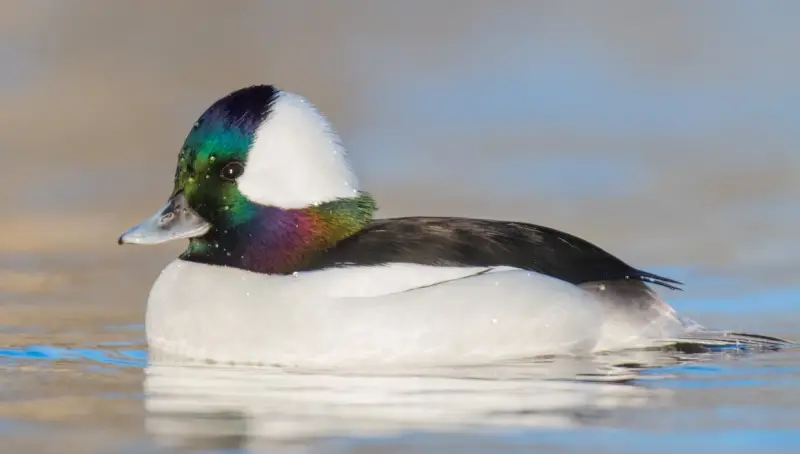
Buffleheads are small ducks known for their large heads. Males are striking with white chests and flanks, a large white patch on their heads, a dark back, and iridescent purple-green plumage on their face. Females are mostly brown with a darker head and a distinctive white cheek patch.
In Michigan, these ducks are easy to spot due to their unique appearance and behavior. They spend up to half their time diving underwater to forage for aquatic invertebrates and crustaceans, so be patient and watch for them to resurface.
Buffleheads are particular about nesting, preferring cavities, usually those made by Northern Flickers or occasionally Pileated Woodpeckers. They are affected by logging but adapt well to properly installed nest boxes. While generally quiet, males produce a squeaky whistle in late winter to early spring.
Canvasback
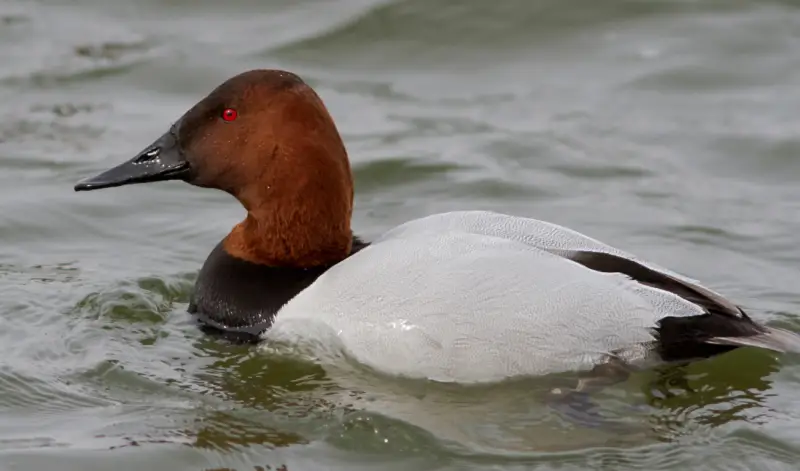
Canvasbacks are large diving ducks easily identified by their wedge-shaped heads that slope down to a long, dark bill. Males have striking red-brown heads and red eyes, paired with a black breast, black tail, and pale gray body. Females are duller, with a brown head and black eyes.
These ducks rarely leave the water, even sleeping while floating and building nests in floating vegetation. They are omnivores, consuming insects, mussels, plant tubers, and seeds. Canvasbacks can dive up to 7 feet deep to forage for aquatic vegetation, which they tear off with their powerful bills.
Although their populations have fluctuated due to wetland habitat loss and a decline in their primary food source, wild celery, Canvasbacks have generally remained steady since the 1980s. They are mostly silent, adding to their distinctive presence in the water.
Hooded Merganser
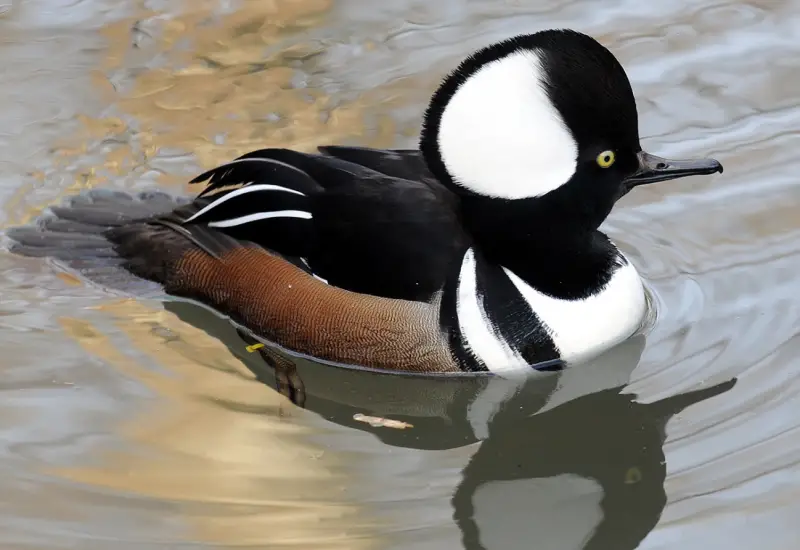
The Hooded Merganser is a small duck with a distinctive appearance and behavior. Breeding males are easily recognized by their large black crest with prominent white patches on each side and bright yellow eyes. Females, on the other hand, have dark eyes and a brown overall plumage with a lighter, mohawk-like crest. Nonbreeding males resemble females but have yellow eyes.
One of the most striking sights is the breeding male with its elaborate black and white crest fully displayed. Hooded Mergansers are typically found in shallow ponds and rivers during the summer, while they migrate to unfrozen lakes and bays in winter.
Their long, slender bill is serrated, ideal for catching small fish, crayfish, and aquatic insects, which they swallow whole. These ducks hunt underwater by sight, benefiting from vision adaptations that enhance their underwater clarity.
Interestingly, female Hooded Mergansers may practice brood parasitism, laying some of their eggs in the nests of other Hooded Mergansers. It’s not uncommon to find nests with over 40 eggs, which means some females end up raising a large number of chicks in addition to their own.
Red-breasted Merganser
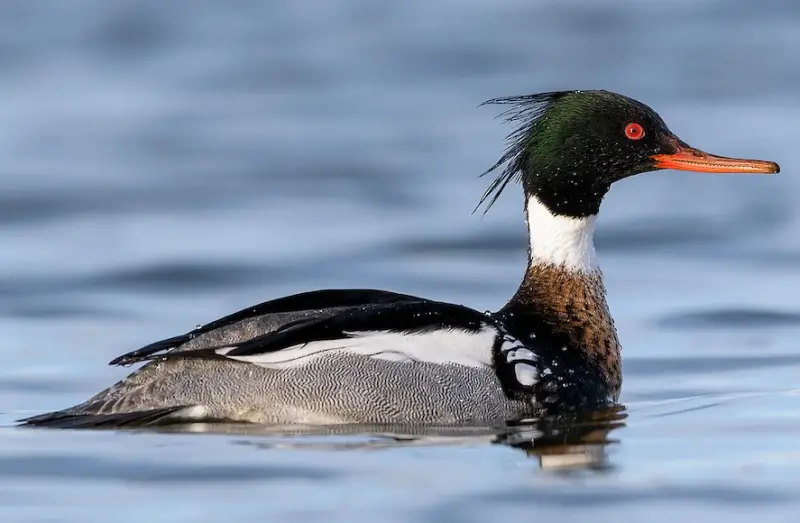
The Red-breasted Merganser is a slender duck known for its long body, neck, and thin bill. Breeding males are striking with their dark green head, spiky crest, cinnamon-colored chest, and red eyes. Females and non-breeding males have a more subdued greyish-brown appearance.
These ducks breed in boreal forests across North America and can often be seen on inland lakes during the summer. In winter, they migrate south and are commonly found just offshore or in large, unfrozen bodies of water.
Red-breasted Mergansers primarily eat fish, consuming around 15-20 per day to meet their energy needs. To catch this many fish, they may dive up to 250 times daily! They sometimes work together to herd minnows into shallower water to make fishing easier.
Interestingly, because fish-eating birds generally taste unpleasant, Red-breasted Mergansers, like other merganser species in Michigan, are not commonly hunted. This is also why penguins are not typically eaten!
Common Merganser
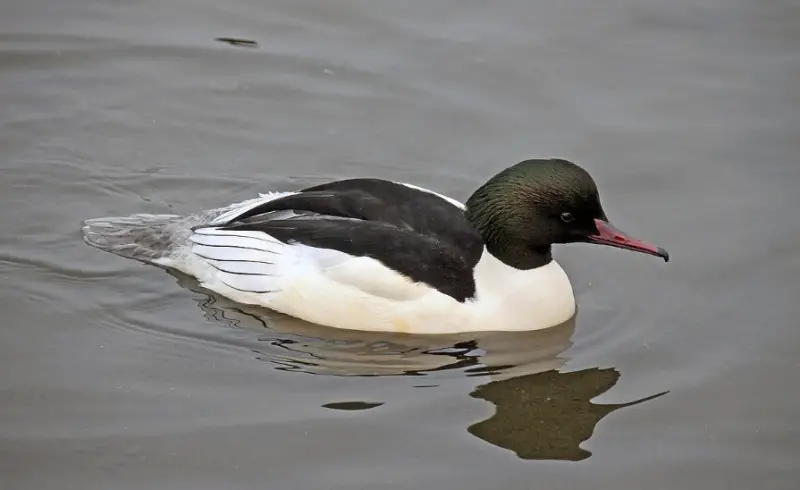
The Common Merganser is a fairly large duck distinguished by its long, slender orange bill with a black tip and dark eyes. Breeding males feature a mostly white body with a black back and a Mallard-like green head. Females and non-breeding males have a cinnamon-colored head and a grayish-white body.
In Michigan, Common Mergansers are relatively easy to identify due to their distinctively thin bill. Their primary diet consists of fish, which they catch with their serrated bills. They also consume aquatic invertebrates like crustaceans, mollusks, insects, and worms.
These adept fishers often attract attention from other ducks, seagulls, and even Bald Eagles, all hoping to pilfer a meal. Common Mergansers nest in tree cavities made by woodpeckers. Remarkably, the ducklings leap from the nest to the ground within a day of hatching and are guided by their mother to water, where they start foraging for their own food immediately.
Lesser Scaup
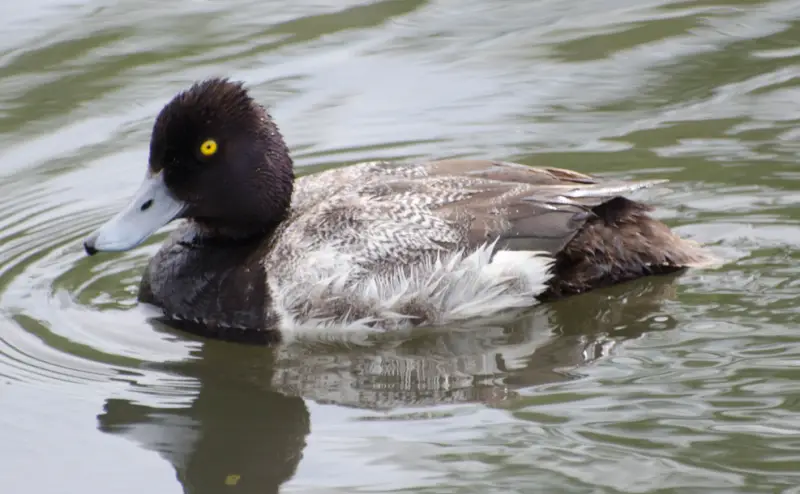
The Lesser Scaup is a diving duck that is the most common of its kind in North America, though spotting one in Michigan can still be a challenge. Males are easily recognizable with their yellow eyes, glossy black heads, and contrasting speckled gray back with white sides. Females are dark brown overall with an even darker head and a distinct white patch around the base of the bill.
Lesser Scaups are typically found in large lakes, reservoirs, and estuaries, where they often form massive flocks during winter. From a distance, these flocks can appear as large patches of floating vegetation.
To differentiate Lesser Scaups from Greater Scaups, observe their head shape: Lesser Scaups have a more tall, peaked head, while Greater Scaups have a rounder head. Lesser Scaups are generally quiet, but females are somewhat more vocal, producing a range of guttural barks and grunts.
Greater Scaup
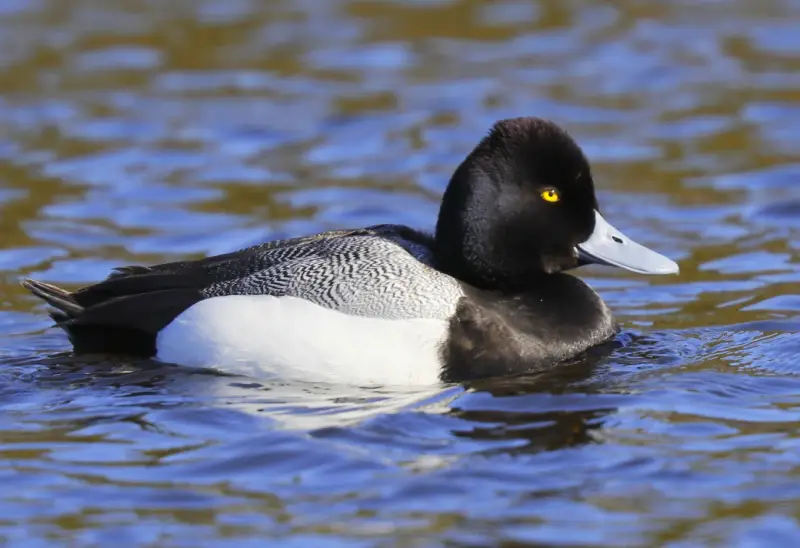
Greater Scaups are large diving ducks found in Michigan, though they primarily breed in the arctic regions, with some even traveling across the North Pole into Europe. Males are distinguished by their yellow eyes, green head, dark chest, and a speckled gray back with white sides. Females have a chocolatey-brown head, a warm brown body, and a noticeable white patch around the base of their bill. Both sexes sport large blue-grey bills with a black tip.
These ducks are often seen in large bodies of water, where they gather in sizable flocks. Greater Scaups closely resemble Lesser Scaups, but they have a rounder head compared to the Lesser Scaup’s more peaked head. While generally quiet, males produce a soft, nasally whistle during the breeding season.


